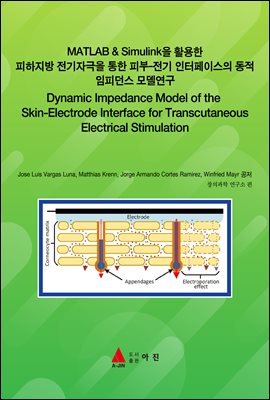
MATLAB & Simulink을 활용한 피하지방 전기자극을 통한 피부-전기 인터페이스의 동적 임피던스 모델연구(Dynamic Impedance Model of the Skin-E
- 저자Jose Luis Vargas Luna, Matthias Krenn, Jorge Armando Cortes Ramirez, Winfried Mayr 저
- 출판사아진
- 출판일2020-07-14
- 등록일2020-12-21
- SNS공유


- 파일포맷PDF
- 파일크기8MB
- 공급사YES24
-
지원기기
PC
PHONE
TABLET
프로그램 수동설치
전자책 프로그램 수동설치 안내
아이폰, 아이패드, 안드로이드폰, 태블릿,
보유 1, 대출 0,
예약 0, 누적대출 9, 누적예약 0
책소개
Transcutaneous electrical stimulation can depolarize nerve or muscle cells applyingimpulses through electrodes attached on the skin. For these applications, the
electrode-skin impedance is an important factor which influences effectiveness.
Various models describe the interface using constant or current-depending
resistive-capacitive equivalent circuit. Here, we develop a dynamic impedance
model valid for a wide range stimulation intensities.
The model considers electroporation and charge-dependent effects to describe the
impedance variation, which allows to describe high-charge pulses. The parameters
were adjusted based on rectangular, biphasic stimulation pulses generated by a
stimulator, providing optionally current or voltage-controlled impulses, and applied
through electrodes of different sizes. Both control methods deliver a different
electrical field to the tissue, which is constant throughout the impulse duration for
current-controlled mode or have a very current peak for voltage-controlled. The
results show a predominant dependence in the current intensity in the case of both
stimulation techniques that allows to keep a simple model. A verification
simulation using the proposed dynamic model shows coefficient of determination of
around 0.99 in both stimulation types. The presented method for fitting
electrode-skin impedance can be simple extended to other stimulation waveforms
and electrode configuration. Therefore, it can be embedded in optimization
algorithms for designing electrical stimulation applications even for pulses with
high charges and high current spikes.
목차
제 1편 : SIMULINK 기본편1.1 SIMULINK의 시작 1
블록의 연결 5
블록 파라미터의 설정 7
시뮬레이션 파라미터 (Configuration Parameters)의 설정 8
시뮬레이션의 수행 9
블록 파라미터의 표시 9
복수 데이터의 표시 11
2.2 동적 시뮬레이션 13
이차 미분방정식 17
선형 상태변수 모델 23
DC 모터의 시뮬레이션 24
함수 블록의 사용 29
차분방정식(difference equation)의 모델링 34
Subsystem(부시스템)의 구성 37
제 2편 : 연구논문
Dynamic Impedance Model of the Skin-Electrode Interface for
Transcutaneous Electrical Stimulation
1. Introduction 41
2. Methodology42
3. Data Processing 47
4. Results 48
5. Discussion 51
6. Conclusions 53
7. References 54














![스마트폰으로 AI음악 만들기[수노,유디오]](/images/bookimg/ebk0/bookimg/150/2408/240800684.jpg)


